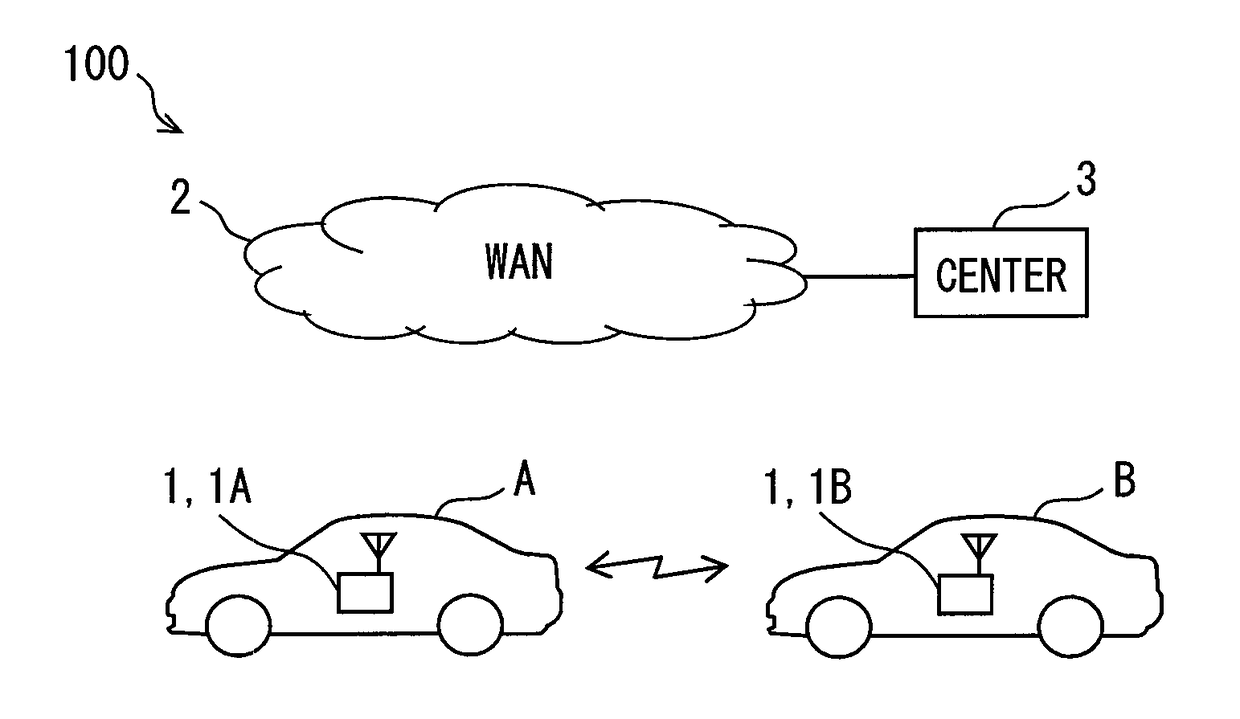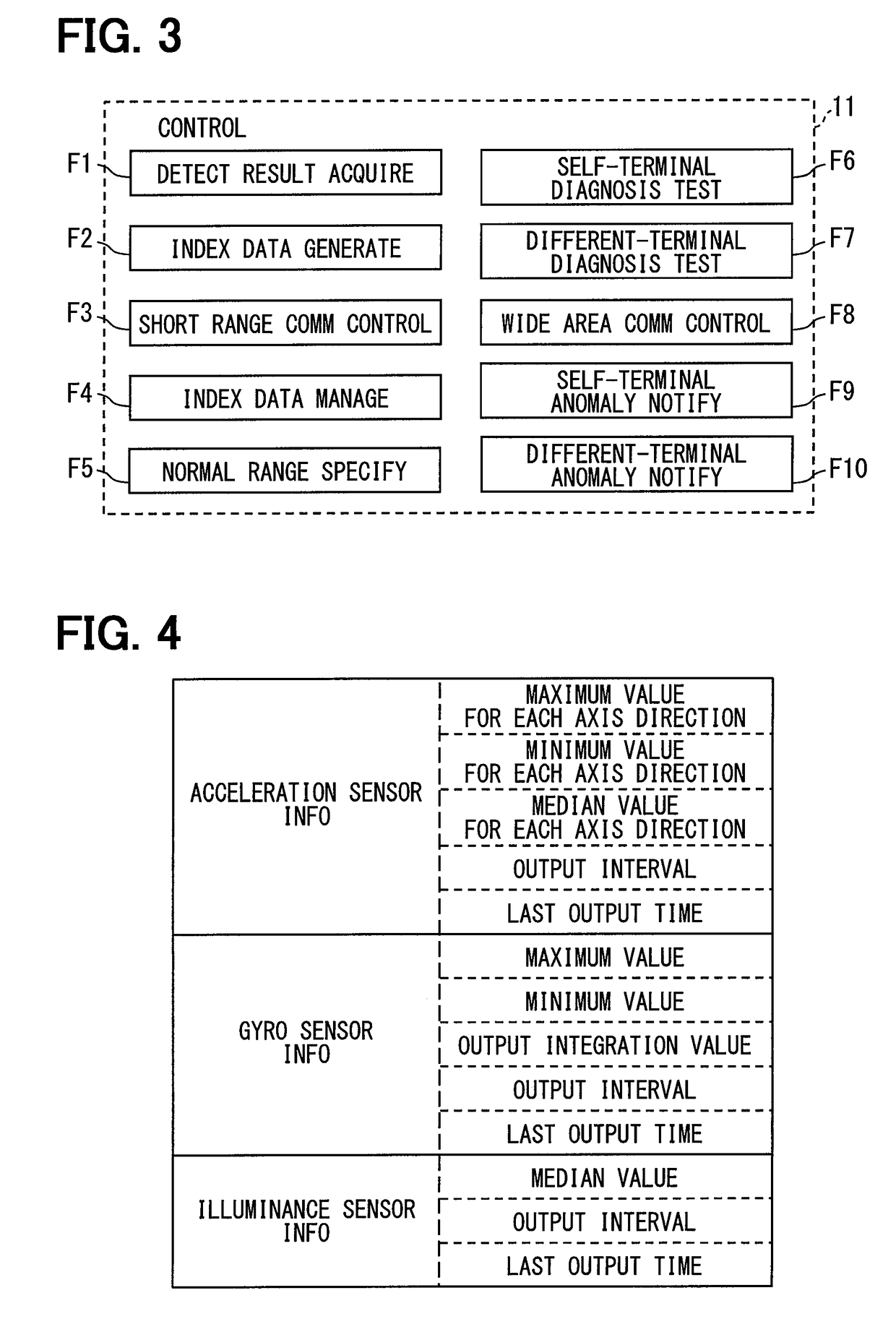In-vehicle unit and in-vehicle unit diagnosis system
a technology for in-vehicle units and diagnostic systems, which is applied in the direction of registering/indicating vehicles, instruments, and vehicle registration/indicating, etc., can solve the problems of difficulty in specifying the operation tendency of various sensors, in-vehicle units may not be able to appropriately obtain the service provided, etc., and achieves the effect of increasing labor hours and increasing costs
- Summary
- Abstract
- Description
- Claims
- Application Information
AI Technical Summary
Benefits of technology
Problems solved by technology
Method used
Image
Examples
first modification
[0172]As above, any of the in-vehicle units 1 in the in-vehicle unit diagnosis system 100 has the same function but is not limited thereto. Different functions may be provided for the in-vehicle unit 1 to be diagnosed and the diagnosing in-vehicle unit 1.
[0173]The in-vehicle unit 1 to be diagnosed just needs to include at least the detection result acquisition section F1, the index data generation section F2, and the short range communication control section F3 having the function to transmit the index data-item of the self terminal.
[0174]The diagnosing in-vehicle unit 1 just needs to include at least the short range communication control section F3 having the function to acquire the index data-item transmitted from the in-vehicle unit 1 to be diagnosed, the index data management section F4, the normal range specification section F5, the different-terminal diagnosis test section F7, and the wide area communication control section F8.
[0175]According to the above-mentioned configurati...
second modification
[0177]The case where the sensor provided for the in-vehicle unit 1 does not operate normally may include a case where the in-vehicle unit 1 is not attached to the vehicle in accordance with a correct posture. The correct posture signifies a predetermined attachment posture.
[0178]The self-terminal diagnosis test section F6 may therefore determine whether the attachment posture of the self terminal is correct. The different-terminal diagnosis test section F7 may determine whether the in-vehicle unit 1Bb as a diagnosis target is attached to a vehicle Bb mounted with the in-vehicle unit 1Bb according to the correct posture.
[0179]As an example, the description below illustrates a mode in which the self-terminal diagnosis test section F6 of the in-vehicle unit 1A determines whether the attachment posture of the self terminal is correct, based on detection values output from the acceleration sensor 15 in the three axis directions.
[0180]The description below first explains the relationship ...
third modification
[0200]The second modification illustrates the mode in which each in-vehicle unit 1 includes the GNSS receiver 14 and the stopping determiner section F11 and uses a result detected by the acceleration sensor 15 while the vehicle stops to determine whether the in-vehicle unit 1 is attached according to the correct attachment posture. However, the mode is not limited thereto.
[0201]The in-vehicle unit 1 may not include the GNSS receiver 14 and the stopping determiner section F11 and use a median in the index data-item for the acceleration sensor 15 in each axis direction to determine whether the attachment posture of the self terminal or the nearby in-vehicle unit 1B is correct in relation to the vehicle. The description below illustrates a mode in which the self-terminal diagnosis test section F6 of the in-vehicle unit 1A determines whether the attachment posture of the self terminal is correct.
[0202]As described in the second modification, no force is generated to act on the in-vehicl...
PUM
 Login to View More
Login to View More Abstract
Description
Claims
Application Information
 Login to View More
Login to View More - R&D
- Intellectual Property
- Life Sciences
- Materials
- Tech Scout
- Unparalleled Data Quality
- Higher Quality Content
- 60% Fewer Hallucinations
Browse by: Latest US Patents, China's latest patents, Technical Efficacy Thesaurus, Application Domain, Technology Topic, Popular Technical Reports.
© 2025 PatSnap. All rights reserved.Legal|Privacy policy|Modern Slavery Act Transparency Statement|Sitemap|About US| Contact US: help@patsnap.com



